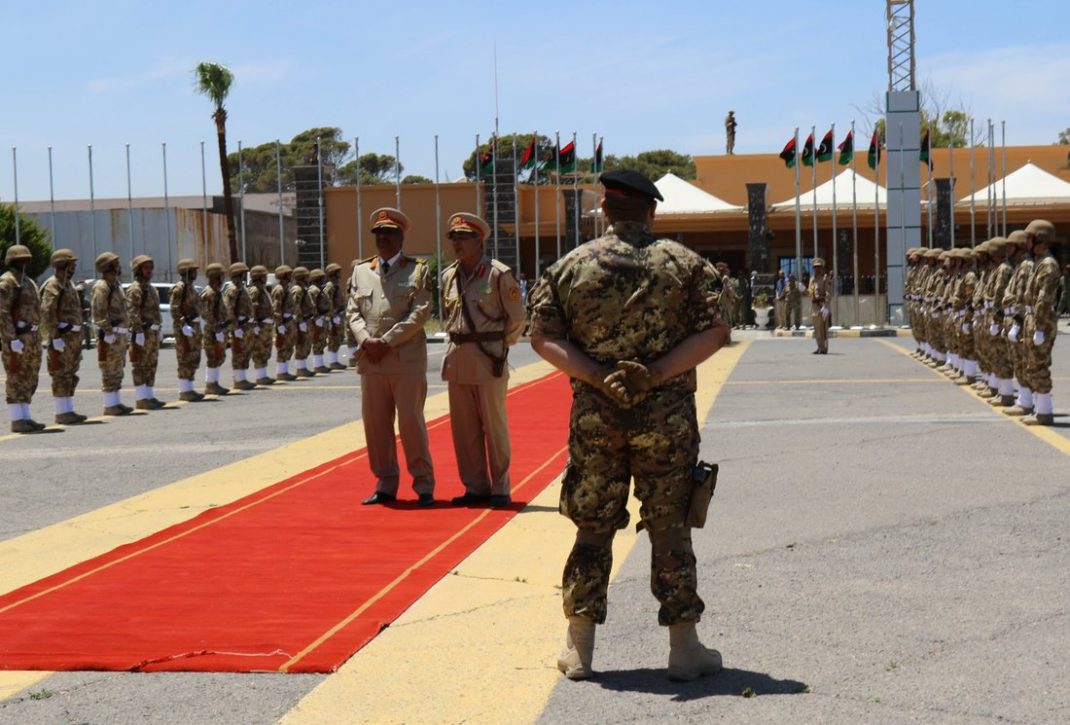Why Backing One Militia Against Another is Not the Solution
By Fredric Wehrey & Emadeddin Badi

 On April 15, President Donald Trump telephoned Libyan militia commander Khalifa Haftar and praised his Libyan National Army’s offensive against the internationally recognized government in Tripoli.
On April 15, President Donald Trump telephoned Libyan militia commander Khalifa Haftar and praised his Libyan National Army’s offensive against the internationally recognized government in Tripoli.
Citing a “shared vision” for Libya, the U.S. president acknowledged Haftar’s value in fighting terrorism, maintaining oil production, and shepherding the country’s democratic transition. But nothing could be farther from the truth.
PART ONE
Haftar’s surprise attack on April 4, dubbed the “Flood of Dignity,” is in fact a brazen grab for power and plunder by an unrepentant authoritarian.
Beyond the humanitarian disaster it has caused — over 400 dead, including civilians, and tens of thousands displaced — it will be a boon to terrorism, especially a resurgent Islamic State, stall oil production, and set back any chance for an inclusive politics.
And ironically, regardless of outcome, it will bolster the influence of the Tripolitanian militias that Haftar ostensibly has pledged to dismantle. His offensive is likely to send Libya into a spiral of low-level militia clashes that could endure for years.
Trump’s comments belie a profound misunderstanding of Libya’s fractured landscape and balance of power.
What is most worrisome is not necessarily his embrace of a fellow authoritarian — though this is disturbing — but his misguided view of Haftar as a game-changing figure who can finally forge a degree of unity and institutionalization.
Such an assumption ignores one of the truths of post-revolutionary Libya: No single military or political actor has been able to exert a preponderance of control and sovereignty.
Libya’s militia bosses and factional elites, including Haftar, have long had a mutual economic and political interest in keeping conflict simmering, eschewing both decisive outcomes on the battlefield and outside attempts to end the fighting.
These armed actors have also have adroitly exploited competing and uncoordinated foreign interests in Libya.
It is not simply Libyan National Army’s internal contradictions and weaknesses limit Haftar’s effectiveness as a would-be proxy for outside powers hoping to unify Libya.
It is the fact that the fractured security landscape of Tripolitania, and its underlying political economy and social demography, have long prohibited any one actor from achieving dominance — especially one coming from the east.
As the most powerful external actor involved in the conflict, Washington’s signals matter.
The State Department and Defense Department may be trying to adopt a more even-handed and realistic policy toward the conflict, but their effectiveness is stymied by the White House’s mistaken — and very public — assumption.
Rather than backing one militia over another, a clear-eyed understanding of the nature of Haftar’s forces, as well as that of his opponents, is crucial to avoiding even more blunders in Libya.
Haftar’s Militias: Neither National nor an Army
Trump’s call appears to rest on a mistaken but well-trodden narrative, advanced by Haftar’s forces, his Arab backers, and his western sympathizers, that the general’s “army” could deal a decisive military blow to Tripoli’s “Islamist and jihadist militias.” But this dichotomy is not anchored to current realities.
After the 2011 revolution, as Benghazi fell into chaos and neglect, there was indeed a very real radical Islamist militia presence, which Haftar’s so-called Operation Dignity coalition started fighting in 2014.
And some of these Islamists were later backed by hardline revolutionary factions in the western Libyan cities of Tripoli and Misrata.
But since Haftar’s military victory in Benghazi and his consolidation of control over eastern Libya, the threat of Islamist militias has diminished significantly.
So has Qatari and Turkish interference in Libya, especially compared to the still-robust role of the United Arab Emirates and Egypt.
In tandem, moderate and pragmatic Libyan factions sidelined the radical presence in Tripoli and Misrata, with many militant figures exiled, imprisoned, or killed.
Thus, it is a mistake to portray Tripoli as awash with radical Islam and Haftar as a savior figure coming to eradicate it.
Aside from this inflated “radical” narrative, Haftar’s forces are hardly the professional army they appear to be. They contain a significant irregular, localized militia component, which includes foreign fighters from Chad and Sudan.
Our interviews with Libyan National Army personnel, U.N. officials, and observers indicate this militia component to be somewhere between 40 to 60 percent of the army’s total.
To be sure, there is a nucleus of regular infantry, armor, air force, and military police units — and it is this professional face that accounts for the public support, based on a recent poll, that Libyans accord the Libyan National Army as a welcome alternative to the country’s unruly and rapacious militias.
But even this narrative is shaky. One of Haftar premier regular units, the Sa’iqa (or Thunderbolt Battalion), often described in the press as an “elite” organization, has been implicated in a string of abuses, and one of its senior officers has been indicted for war crimes by the International Criminal Court.
Moreover, ever since Haftar started his military campaign in Benghazi in 2014, he has relied heavily on locally constituted militias. Denoted by the euphemism “support forces” or “neighborhood youths,” these militias were tied to specific Benghazi suburbs, and many hailed from an influential local tribe, the Awaqir.
These support forces acted, in effect, as rear area guards, but also assisted regular units in frontline assaults. As the conflict dragged on, they also engaged in violent vigilantism, attacking the homes and businesses of Benghazi families suspected to be loyal to Haftar’s Islamist opponents.
The presence of conservative Salafists in the Libyan National Army also belies the notion that Haftar’s forces are an institutionalized, professional force.
Backed by Qadhafi in the waning years of his rule, these Salafists had a presence in the former regime’s security forces and are doctrinally hostile to the political Islamists Haftar was fighting.
Salafist fighters have been crucial frontline combatants for the Libyan National Army. In areas of the east that Haftar has taken over, they’ve enjoyed some latitude to try and enforce their version of Islamic social mores.
All of this suggests that any Trump administration support for Haftar on ideological grounds is misplaced. He is certainly a foe of the Muslim Brotherhood, which the White House is unwisely trying to designate as a foreign terrorist organization. But he is no secularist.
More recently, Salafists have joined Libyan National Army military units commanded by Haftar’s sons. This familial dimension of Haftar’s forces is yet more evidence that the Libyan National Army is not all that it seems.
Our interviews with members of the group and its supporters suggest that with minimal military training, Haftar’s sons Khalid and Saddam were elevated to command positions, part of a broader trend of Haftar ruling through a tight clique of family members and confidantes from his tribe, the Firjan.
In particular, Khaled’s unit, the 106th Brigade, has received high-end foreign equipment and weapons, leading to frequent comparisons to Libya’s most elite formation during the Qadhafi era, the 32d Reinforced Brigade, commanded by Qadhafi’s youngest son Khamis.
Finally, the acquiescence and, in some cases, active support that Haftar’s Libyan National Army enjoyed from foreign powers have also been crucial to the army’s expansion.
The United Arab Emirates, Egypt, France, and Russia each backed the Libyan National Army for their own reasons (whether anti-Islamism, border control, or counter-terrorism).
Haftar, like many Middle Eastern proxies, has proved adroit at exploiting this patronage .
And the United States also shoulders some blame: Though Washington reportedly halted military engagement with Haftar’s side in 2015, American diplomats, based on our interviews, evinced an increasingly accommodative stance toward the general, hoping to bring him into the political process and taking at face value his professed support for elections.
They also adopted a muted position toward his military move across Libya’s vast southern region earlier this year, which Haftar’s camp likely perceived as a tacit green light.
During this southern advance, a security and governance vacuum allowed the Libyan National Army to effectively flip locally constituted militias — including those guarding oil installations — with offers of cash and equipment.
In turning to attack Tripoli, Haftar adopted a similar strategy, hoping local militias in Tripoli and its environs would come to his side, persuaded by a mix of cash, force, and self-interested political calculations. But that plan has backfired spectacularly.
Disparate militias in Tripoli that had long been at loggerheads have unified against him. Even ordinary citizens who might have welcomed Haftar into the capital as relief from the militias are turning against him.
Understanding the fractured political and security backdrop against which the Libyan National Army has encountered these obstacles is important for understanding why Trump’s faith in Haftar is misplaced.
***
Frederic Wehrey is a senior fellow at the Carnegie Endowment for International Peace and the author of The Burning Shores: Inside the Battle for the New Libya (Farrar, Straus & Giroux, 2018).
Emadeddin Badi is a non-resident scholar in the Counterterrorism Program at the Middle East Institute.
________________________
WAR ON THE ROCKS




